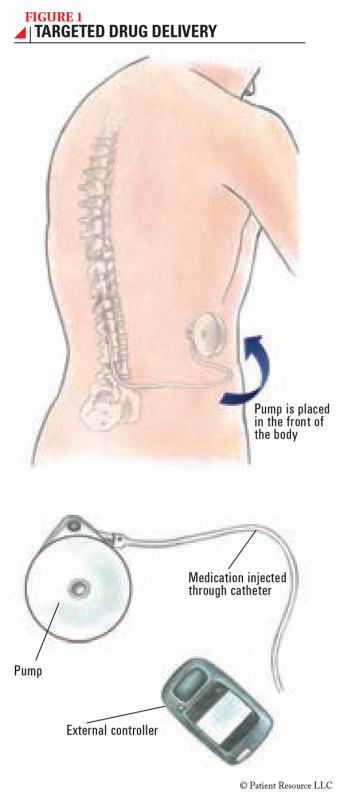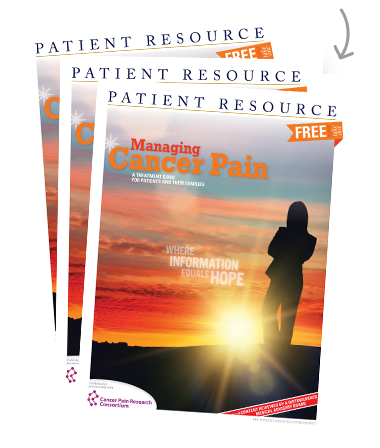Pain
Targeted drug delivery
If you cannot find pain relief with other routes of pain medication (oral, intravenous, etc.) or you have side effects that you cannot tolerate, targeted drug delivery may be an option. A targeted drug delivery system consists of a small pump and a catheter that delivers pain medication directly to the intrathecal space or the fluid surrounding the spinal cord (see Figure 1). The system has been shown to be safe and effective and can be used for patients at all stages of the care continuum, especially during end-of-life care.

How the procedure is done
A screening test, or trial, may be done before the procedure to help ensure that targeted drug delivery is a good choice for you. The trial may allow you to experience how the drug delivery system will control your pain and will enable your doctor to determine how much and what kind of medication you will need. The screening test usually takes place in a hospital or surgical center.
If the trial is successful, a surgeon will perform a minimally invasive surgery to implant the drug pump, often in the abdominal wall. The pump is about three inches in diameter, the size of a hockey puck, but thinner. A catheter (a thin, flexible tube) is inserted into the spinal fluid in the intrathecal space and is then connected to the pump under the skin. The surgery typically takes less than an hour, and patients can usually go home the same day or the next day and return to normal activities within a few days. The pump has an internal battery that allows it to work for about five to ten years. It is filled with medicine and will need to be refilled during a short office procedure, usually every one to three months.
How the system works
Targeted drugs, delivered directly to the spinal fluid, act on pain receptors in the spinal cord. Because these drugs do not need to diffuse throughout the whole body before arriving at their targets in the brain and spinal cord, better pain control can be achieved at much lower drug doses. And lower doses mean fewer side effects.
A member of your treatment team will use a needle to fill the pump with pain medication and will program the pump to automatically send a constant and specific dose of the medication through the catheter, providing relief. The pump can be refilled as necessary and the drug can be changed or the dose can be adjusted to find the combination that best manages your pain. Some targeted drug delivery systems include a hand-held device that allows you to push a button to receive an extra dose of medication to manage breakthrough pain. Even if this device is included, your doctor will set a limit on how much medication can be delivered and over what period of time.
If you or your doctor decide at any time that targeted drug delivery is not effective or is not the right choice for you, the system can be removed.
Possible benefits and risks
Targeted drug delivery is a powerful tool for managing pain that has not responded to other approaches. Patients with a targeted drug delivery system are less likely to need emergency department care or hospitalization for pain management. And they are more likely to be able to carry out normal activities with an improved quality of life. In addition, the common side effects of strong pain medications, such as lethargy, loss of appetite, nausea and constipation, can be avoided.
These benefits come with some potential risks. Because surgery is needed to implant the system, you will need anesthesia for the procedure. The normal risks of surgery, including infection and bleeding, are possible.
Be sure to discuss the possible risks and benefits with your doctor when making a decision about a targeted drug delivery system. If this system is not an option or is not effective for you, other interventional approaches are also available.



